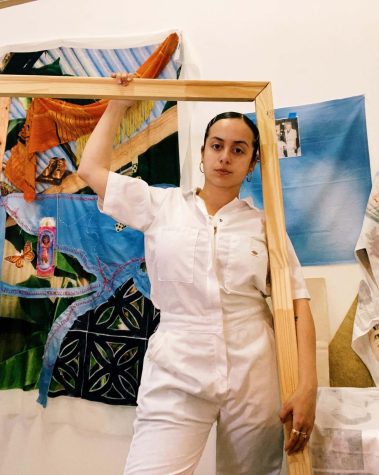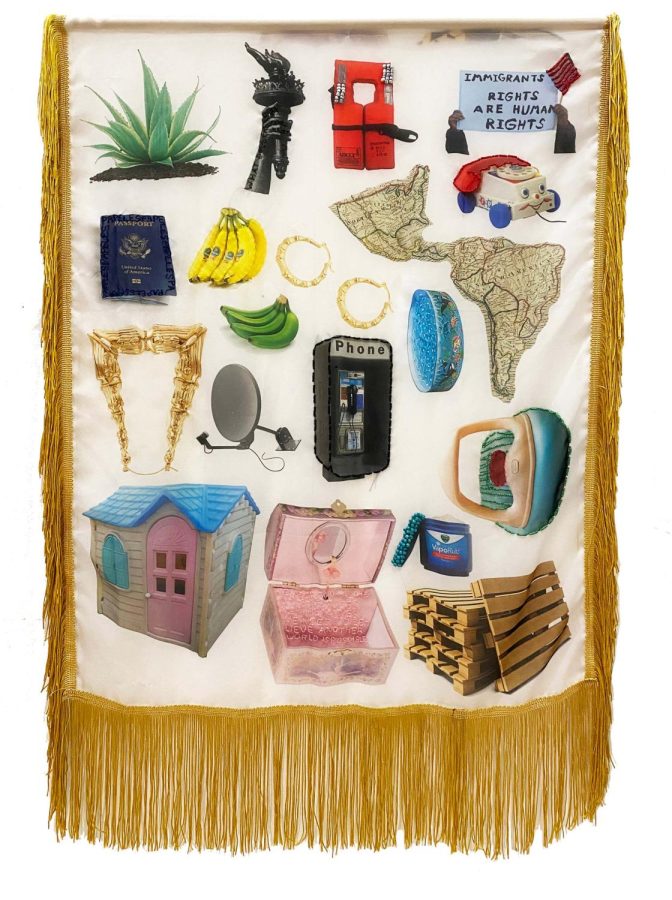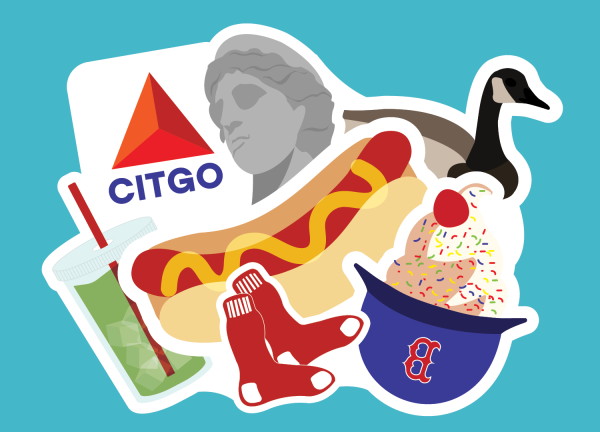Paola de la Calle explores nostalgia in textile acquired by Simmons
April 14, 2022
The Simmons University Collection has recently acquired Colombian-American artist Paola de la Calle’s exciting and unique textile, Untitled (Nostalgia). The piece comes to Simmons through “Collecting & Connecting,” a student-led program designed to diversify the Simmons University Art Collection. Through prints, textiles, and collage, de la Calle has explored topics ranging from home and displacement to identity and nostalgia.
Where did you grow up and how did this influence/affect your work? What first drew you to art?
I grew up between the greater Boston area and Medellin, but I call Cambridge home. Feeling a sense of home in two separate countries with socio-political links to one another greatly influenced and continues to inspire my work. There’s a constant dialogue I’m having between the memories I have in each country and that dialogue is the source of my research, as well as, the images and iconography I pull from and gravitate to which inform my collages.
Where did you go to college and what did you study? Did this have any influence on your work today?
I majored in Sociology and minored in Studio Art and Intergroup Relations at Skidmore College. Though I’d spent four years in High School studying Graphic Design, my parents didn’t want me to focus my studies on art. They didn’t see it as a viable way to make a living so instead I majored in Sociology and focused most of my studies on the social sciences until I studied abroad in Madrid my Junior year. Looking back now, I’m grateful that I came to my practice in a roundabout way because what I was learning through my Sociology degree informed the work that I eventually began making in the printmaking studio. Sociology gave me the language to talk about my own experiences and the ability to ground my early political printmaking work in research.
How would you describe your style? How has it changed over time?
I’m not totally concerned with style. When I first began calling myself an artist I was concerned with making sure my work was recognizably mine and that my style was distinct. But what I know about making art is that you just have to make it, you have to express yourself and your point of view and if you do that for long enough your style will emerge – maybe. Style changes overtime and I think that’s the beauty of making art and growing as an artist. Sometimes I think finding or having a style can be limiting as an artist. I’m currently at a place in my career where I want to be free to explore materials and ideas I haven’t yet discovered and being boxed into a specific style or way of making would hinder that.
What are your favorite mediums to work with? Why are they your favorite?
Currently I’m enjoying working with textiles and exploring staining fabric with coffee. I’m looking for spaces where I can continue playing with ceramics and figuring out ways to incorporate that into my textile practice. Right now these are my favorites because I’m leaning back into the feeling of dirt between my nails and stained clothes I will never be able to wear outside of the studio again. It’s childlike and playful and that’s my favorite way to be in the studio.
We would love to hear more about your work Untitled (Nostalgia). We noted the embroidered script and beading on several of the object images in the piece. Is there anything you can tell us about the meaning behind this work and/or the materials you used?What is your process in creating your work? Where do you find inspiration?

Untitled (Nostalgia) came to be during a period where I was making the transition from works on paper to fabric. I started the piece in 2019 before the shelter-in-place order in San Francisco and throughout the 2020 the work evolved over time. The work first began as a file I set up to print for collages. The plan was to cut them out individually, if it had gone according to plan they would have likely ended up in different artworks, but when I printed the images and I saw them together cutting them felt wrong. Each image in the work is an object that holds space in my memory, that brings me nostalgia, that I have a story attached to. The plastic house is one my sisters and I played with as children, the wooden crates are reminders from my parents’ storage unit, the TV satellite reminds me of East Boston, and within those images that hold space in my mind and stir up feelings of nostalgia there are references to borders, papers, and bananeros. The embroidered words came to be during the shelter-in-place order “papeles” around the passport during a time when borders were closed and “we need 2 imagine other futures new realities we need to believe another world is possible” during a period of desperation. For me, adding text provides context and adding beads signifies importance . In this work it does both, but it also provided a meditative space during an isolating time.
How do you find a work-life balance as an artist?
Finding a balance between living and making work can be challenging because there’s this idea that an artist needs to be constantly in the studio, hustling, grinding, etc. but what I’ve learned is that experiences make for great art, seeing art in other spaces (like going to the movies, seeing a concert, going to an open mic) is inspiring, and not all studio days look and feel the same. Getting space from work you’re making, from whatever’s going on in your head is crucial and makes the time spent in the studio more productive. Once I realized that, I stopped putting so much pressure on myself to make for the sake of making because learning that there are ebbs and flows in the process is essential.
How do you find support within the arts community?
You have to go where your people are and find ways to support other artists, curators, etc. first. Kiara Cristina Ventura, Founder and Curator of Processa, often talks about building community rather than networking in the arts and it’s a mindset and practice I think we should all adopt. I’ve learned everything I know because of other artists, curators, and mentors so approaching the arts with an abundance mindset – there’s enough for all of us – ensures that we create a supportive space for all.
Join us for a virtual “Collecting & Connecting” Artist Talk with Colombian-American artist Paola de la Calle to discuss our exciting new acquisition, followed by a Q&A! Register here.








